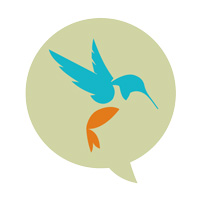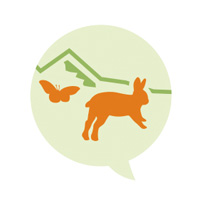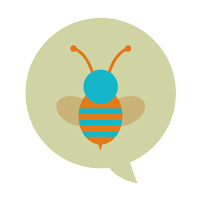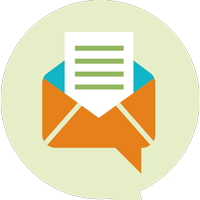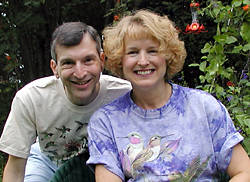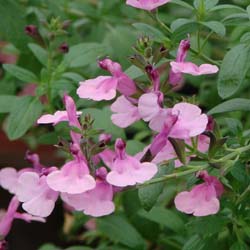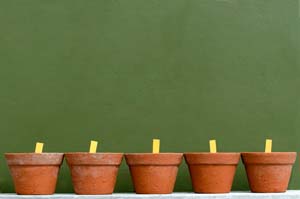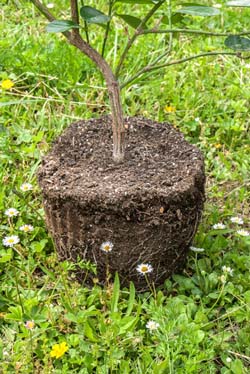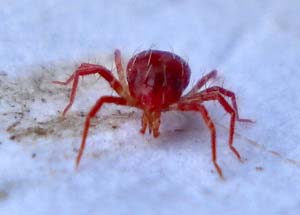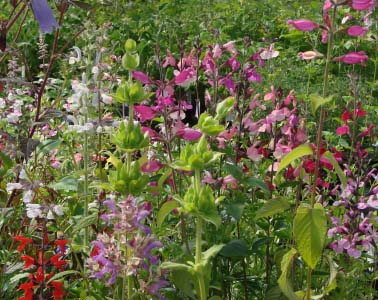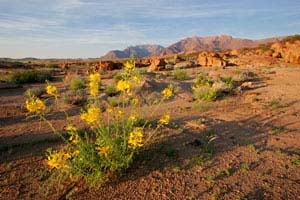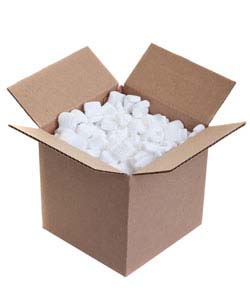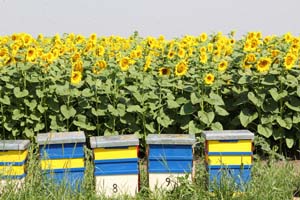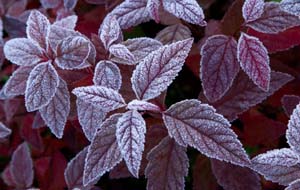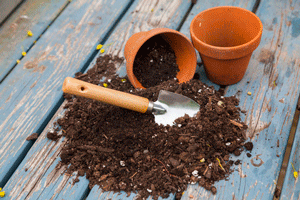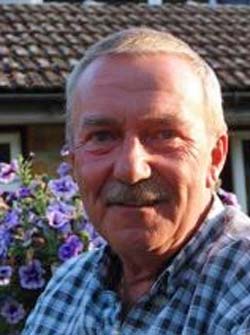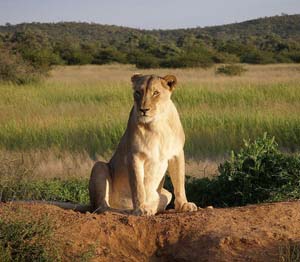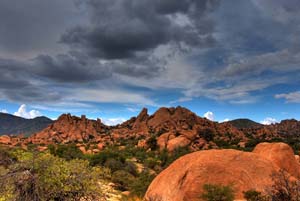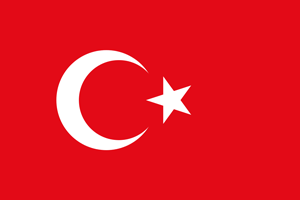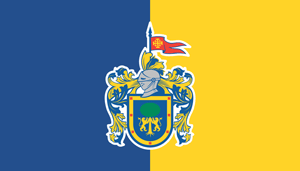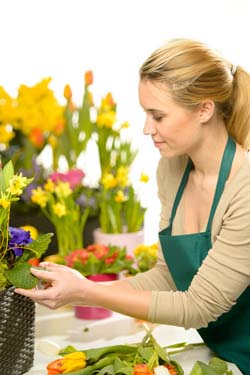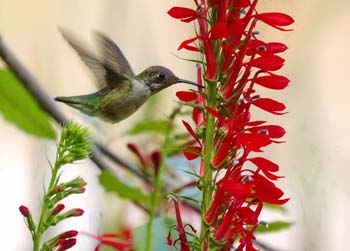
We began publishing our Everything Salvias blog in 2010 for your enjoyment and to help you "get it right" when growing sages that are often unavailable at local garden centers.
It seems like there is an endless bounty of stories to be told. But that's to be expected when covering a genus containing an estimated 900 species -- the largest group within the mint family (Lamiaceae). In addition to Salvias, we write about other species that are either mint family members or low-water companions for our many drought-tolerant Salvias. We welcome comments as well as suggestions for future blog posts.
To access articles rapidly based on your interests, please click on the categories below, which include do-it-yourself videos (Views from the Garden). But please note: This is a dangerous place for a sage lover.
| Explore the Categories: | ||||
| | | | | |
| | | | | |
| | | | | |
| | | | | |
| | | |||
Posted: Wednesday, November 26, 2014
Synopsis:
A wedding gift led to Kathi Johnson Rock and Michael Rock's passion for hummingbirds. These Wisconsin birders offer tips and plant suggestions for hummingbird gardeners at FBTS. Although now known as Madison's "Hummingbird People," the Rocks aren't ornithologists or biologists. They are home gardeners and customers of Flowers by the Sea. This article includes a list of favorite hummingbird plants found in the Rocks' gardens.
Read the Article
Posted: Thursday, November 20, 2014
Synopsis:
Harsh winter weather in areas that normally have mild conditions can bring unwelcome surprises, including the death of favorite plants. This article talks about how and when to remediate frost damage to favorite Salvias in warmer USDA Cold Hardiness Zones. It concludes with a sidebar about a harmful cold snap in California's Bay Area that killed plants as well as birds in 1972 and which changed planting choices at the University of California Botanical Garden at Berkeley. Ask Mr. Sage is a regular feature that is based on topics raised in calls and emails we receive at Flowers by the Sea.
Read the Article
Posted: Sunday, November 16, 2014
Synopsis:
Luminous Salvia x jamensis pastel flowers began warming up nursery catalogs in the late 1990s. Their journey from steep Mexican mountains to American and European gardens began in the mid-19th century with the discovery of Autumn Sage (Salvia greggii). This is the second post in a two-part article about these Jame Sage hybrids of Autumn and Mountain Sage (S. microphylla). It includes descriptions of ten favorite Jame Sages.
Read the Article
Posted: Friday, November 7, 2014
Synopsis:
Ask Mr. Sage answers questions based on calls and emails that Flowers by the Sea receives. This one concerns how to select plants when you move to a different USDA cold hardiness zone, such as in a warmer climate.
Read the Article
Posted: Monday, October 27, 2014
Synopsis:
By spacing Salvias properly when planting, you avoid problems caused either by overcrowding or leaving too much space around individual plants. Most Salvias are healthier with good air circulation. Crowding leads to the spread of fungal diseases and pests, such as spider mites. Too wide of spacing may cause branches to break in high winds. By paying attention to plant measurements before planting, you can create a good spacing plan. Ask Mr. Sage is a Q&A feature based on topics raised in calls and emails to FBTS.
Read the Article
Posted: Sunday, October 19, 2014
Synopsis:
Learn how to prevent root rot and keep dry-garden Salvias healthy by providing optimum growing conditions and avoiding overwatering. Ask Mr. Sage is a Q&A feature based on topics raised in calls and emails to Flowers by the Sea. This one, which concerns a Salvia species that is drought resistant and native to a dry climate, considers how to identify and prevent rot caused by a complex of soil pathogens that attack when roots.
Read the Article
Posted: Wednesday, October 15, 2014
Synopsis:
Beneficial insects help control destructive insects in greenhouses and gardens. Flowers by the Sea uses beneficials to keep plants free of pests and to avoid use of harmful pesticides. FBTS is a horticultural farm in Northern California specializing in hundreds of ornamental Salvia species. In this video, FBTS horticulturist and co-owner Kermit Carter talks about the use of predatory mites called Persimilis and Fallacis to attack plant-eating spider mites and Encarsia wasps to control whiteflies. Carter shows how a tiny box from an insectary contains thousands of helpful insects, including ladybugs, which keep his farm free of pests. The microscopically small predatory mites come packaged with bean leaves that make it easy to distribute them in the garden. Paper strips for overhead hanging contain the wasp eggs. This video is part of the FBTS Everything Salvias Blog series Views from the Garden.
Read the Article
Posted: Thursday, October 9, 2014
Synopsis:
December 18, 2018 - With great sadness we have learned that our friend Rich as passed away at his home in Candor, NC.
A chance encounter with Pineapple Sage led organic chemist Dr. Richard F. Dufresne to become one of America's leading Salvia researchers. Sage Experts focuses on specialists -- both professionals and amateurs -- who have helped popularize the Salvia genus. Dufresne's life course changed the day he visited Rhode Island's Biodynamic Meadowbrook Herb Farm. Discovering the heady pineapple fragrance of Salvia elegans at Meadowbrook gave him a cause.
Read the Article
Posted: Wednesday, October 8, 2014
Synopsis:
You don’t have to be a florist to create eye-catching designs with dramatic Salvias. By planting the right Salvias and complementary flowers in your garden as well as gaining a little knowledge about color combinations, well-balanced compositions, simple tools and cut-flower preservation, you are on your way.
Read the Article
Posted: Sunday, October 5, 2014
Synopsis:
Overwatering harms desert plants more than underwatering. When growing them, you need to consider the quantity, duration and timing of watering. Excellent soil drainage is also essential. This article talks about how to identify overwatering and establish an effective watering schedule. Ask Mr. Sage is a Q&A feature based on topics raised in calls and emails to FBTS.
Read the Article
Posted: Friday, October 3, 2014
Synopsis:
It isn't easy being completely green. Flowers by the Sea explains why polystyrene packing peanuts are essential for shipping and what you can do with them after unpacking your orders. Ecofriendly reuses include donating them to shipping companies and using them to lighten container plantings. Ask Mr. Sage is a Q&A feature based on topics raised in calls and emails to FBTS.
Read the Article
Posted: Monday, September 29, 2014
Synopsis:
Forgive the bad pun, but we almost wouldn't be without bees. These tiny pollinators make it possible for us to eat and experience the flowering beauty of the world around us. Honeybees -- the kind managed by beekeepers -- and thousands of wild species pollinate at least one-third of the plant species we eat. At Flowers by the Sea we've decided to improve our efforts to help the genus Apis. Our first step is to make it easier for you to find plants honeybees frequent by making our catalog easier to search for bee favorites.
Read the Article
Posted: Tuesday, September 23, 2014
Synopsis:
It isn't easy describing green in the garden. Foliage can span greens so pale they are almost white to blue-greens so deep they murmur the forest primeval. Amid this range, you'll find shimmering silver- and gray-leaf species. To locate these types of Salvias and companion plants in the Flowers by the Sea catalog, please visit our "Gray and Silver Leaf Plants" category in the FBTS catalog menu. This article includes a small sampler of our selection.
Read the Article
Posted: Saturday, September 20, 2014
Synopsis:
Summer and fall pruning of Salvias requires only light trimming of spent blossoms, which is known as deadheading. It increases bloom for Autumn Sage (Salvia greggii) and Mountain Sage (Salvia microphylla), which are particularly abundant bloomers in autumn. In this video from Northern California's Flowers by the Sea farm, FBTS horticulturist and co-owner Kermit Carter shows how to use sharp hand pruners to quickly remove flower spikes that have gone to seed. Carter explains how flowering plants have less energy to put into blossoming if they are setting seed. Removal of spent blossoms improves a plant's appearance and makes continuous bloom possible. FBTS specializes in the Salvia genus, which contains about 1,000 species. This video is part of FBTS Everything Salvias Blog series Views from the Garden.
Read the Article
Posted: Saturday, September 20, 2014
Synopsis:
Learn how to determine the best start and stop times for fall planting. Ask Mr. Sage is a Q&A feature based on topics raised in calls and emails to Flowers by the Sea. This post concerns fall planting and provides tools for making decisions based on local frost dates and temperatures.
Read the Article
Posted: Thursday, September 18, 2014
Synopsis:
When a container-planted Salvia grows too large for it pot, it's time to move it to roomier quarters. But how much extra space is too much and what kinds of containers are best? In this video from Northern California's Flowers by the Sea family farm, FBTS horticulturist and co-owner Kermit Carter shows how to select the right size of pot for a Salvia based on its size and need for moisture. He talks about the differences between plastic and clay pots: Carter explains that although plastic pots may be best for conserving moisture in semi-arid parts of the nation, he prefers terra cotta clay pots for their better breathability and drainage. FBTS specializes in the Salvia genus, which contains about 1,000 species. This video is part of the FBTS Everything Salvias Blog series Views from the Garden.
Read the Article
Posted: Monday, September 15, 2014
Synopsis:
Sage Experts focuses on Salvia specialists -- both amateurs and professionals -- in settings ranging from home gardens to university laboratories. This article concerns Robin Middleton of Surrey, England, and his popular Robins Salvias website. The longtime horticulturist grows more than 100 Salvia species and cultivars in his garden and greenhouses.
Read the Article
Posted: Thursday, September 11, 2014
Synopsis:
Before planting a Salvia in the ground or moving it to a larger container, you should determine whether it has become rootbound and needs to have its rootball loosened. Salvias tolerate being rootbound more easily than most flowering plants. However, a Salvia needs extra attention before replanting if its roots dangle from the pot's drain holes and are so dense that they overwhelm the soil. Then the rootball feels too firm and can't be replanted as is. In this video from Northern California's Flowers by the Sea family farm, FBTS horticulturist and co-owner Kermit Carter removes several plants from their containers to show different stages of heavy rooting. Carter demonstrates a variety of methods for loosening roots and soil before replanting. FBTS specializes in the Salvia genus, which contains about 1,000 species. This video is part of the FBTS Everything Salvias Blog series Views from the Garden.
Read the Article
Posted: Thursday, September 11, 2014
Synopsis:
Orange is an aggressive color in the garden. It doesn't purr. The fuzzy, shaggy, hot orange flowers of Lion's Ear (Leonotis) growl for attention. Their stems are so tall that they may reach up to 6 feet, towering over the foliage like gawky Dr. Seuss blossoms. You'll find them at Flowers by the Sea Online Nursery.
Read the Article
Posted: Monday, September 8, 2014
Synopsis:
Portraits in Gardening is a blog series from Flowers by the Sea that profiles customers who are passionate about the Salvia genus. This article focuses on wildlife gardener, birder and dedicated volunteer Ward W. Dasey III, who grows Salvias at New Jersey's Palmyra Cove Nature Park. Dasey and nature-loving friends proposed the park to make bird watching easier on the Delaware River.
Read the Article
Posted: Monday, August 25, 2014
Synopsis:
Many gardeners and wildlife lovers in states with recurrent drought choose to increase the number of native plants in their yards. This is especially true of Texas, where statewide drought began in 2010 and hasn't yet abated. Native plants appeal to local wildlife, including pollinators. To help gardeners from Texas and the Southwest who want to create wildlife habitat, Flowers by the Sea (FBTS) suggests Salvias appropriate for Texas and Southwest gardens.
Read the Article
Posted: Saturday, August 9, 2014
Synopsis:
Ask Mr. Sage is a question-and-answer feature based on topics raised in calls and emails that Flowers by the Sea receives. This post concerns the FBTS "Email Me When Back in Stock" button -- a feature on our plant description pages that allows customers to request notification as soon as out-of-stock plants become available again.
Read the Article
Posted: Thursday, August 7, 2014
Synopsis:
The FBTS Sage Experts series focuses on Salvia specialists -- both amateurs and professionals -- in settings ranging from botanic gardens to universities. This article focuses on Jesús Guadalupe González-Gallegos of the University of Guadalajara, an expert in the taxonomy of Salvias native to Western Mexico. He discusses the megadiversity of Mexican flora and problems involving incorrect identification of sage species.
Read the Article
Posted: Wednesday, August 6, 2014
Synopsis:
Southern California urban homesteader Kate Richards offers good advice for incorporating Salvias into country-style bouquets. Richards gained her flower-arranging experience while working in the floral industry, but you don't have to be a florist to design beautiful bouquets.
Read the Article
Posted: Monday, August 4, 2014
Synopsis:
Top-10 lists of hummingbird favorites almost always contain Salvia and Lobelia, because each genus is nectar rich and offers many species in bright reds, oranges and pinks. Hummingbirds have a weak sense of smell, but bright colors, such as those of Lobelias, lure them to flowerbeds. They are particularly devoted to the types grown at Flowers by the Sea.
Read the Article





